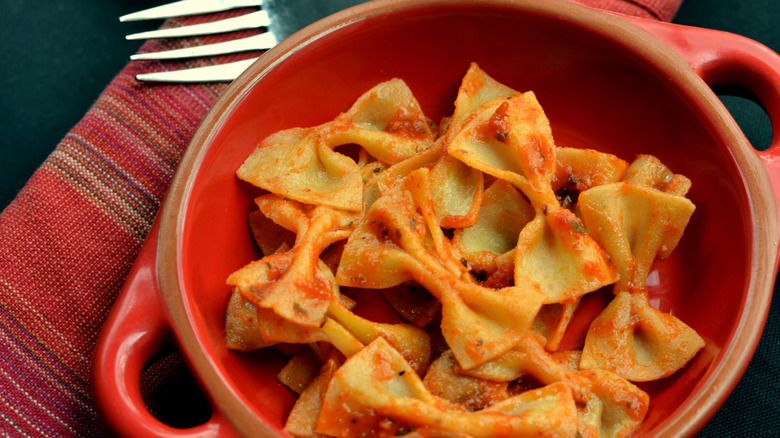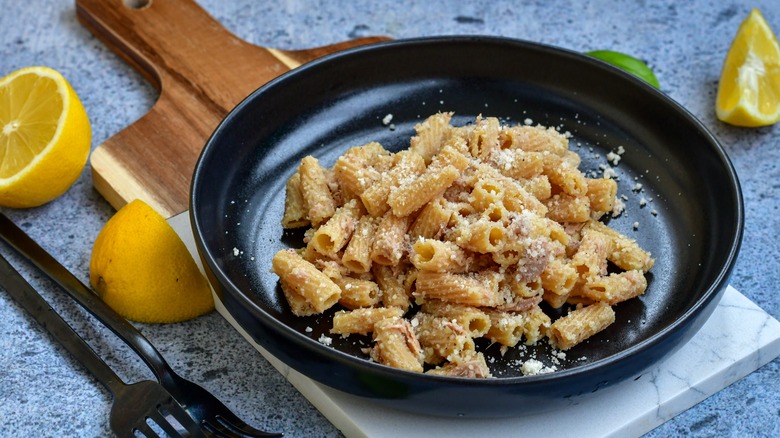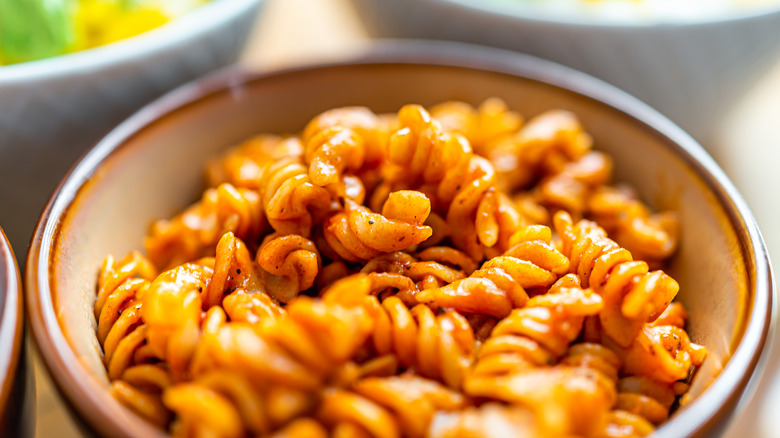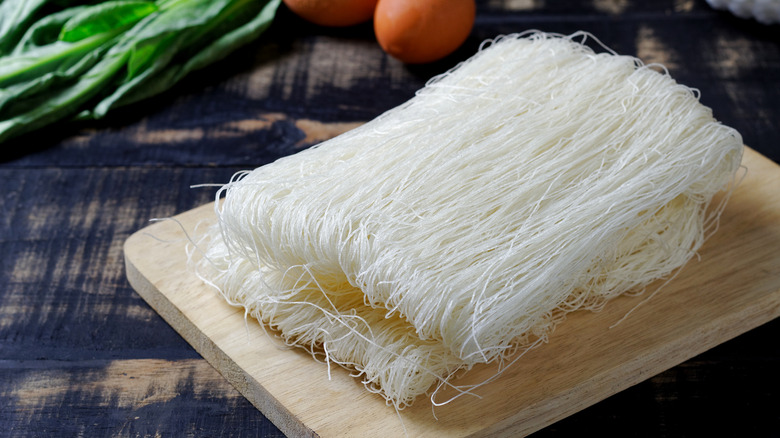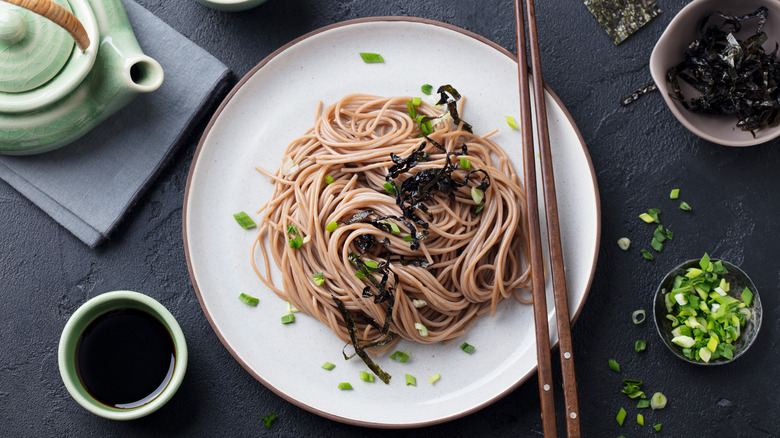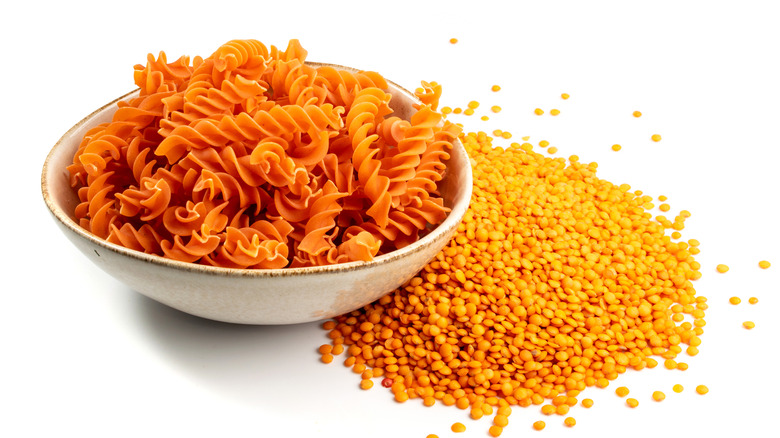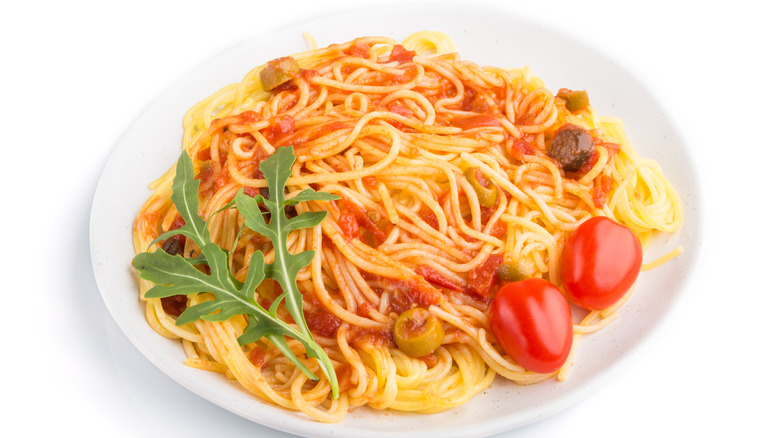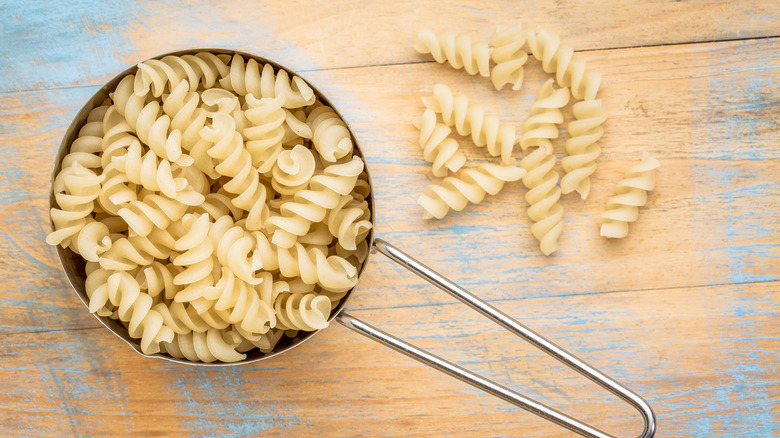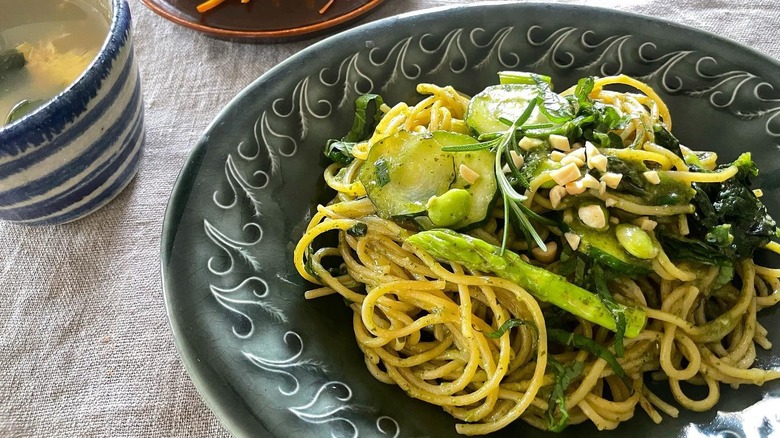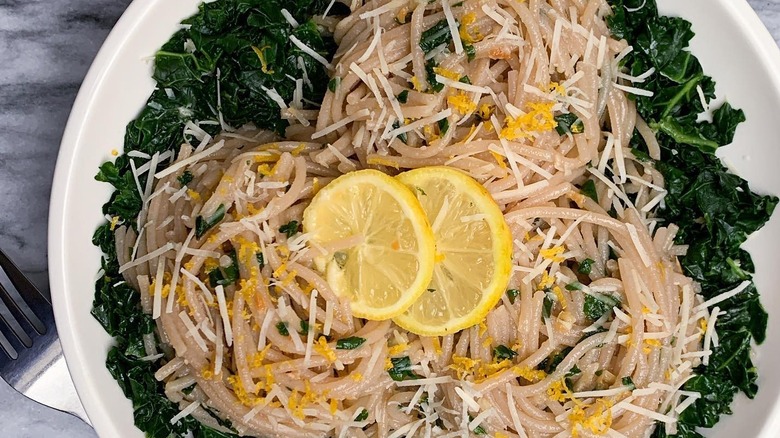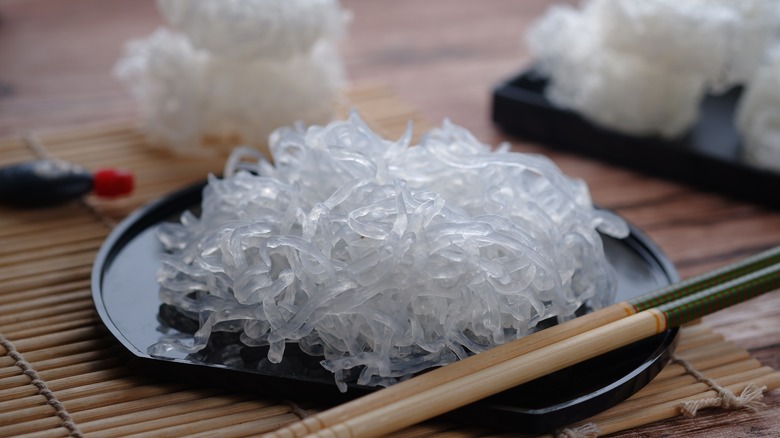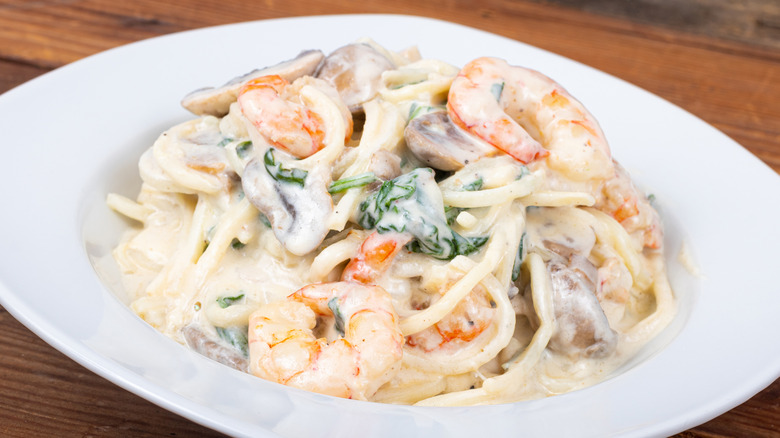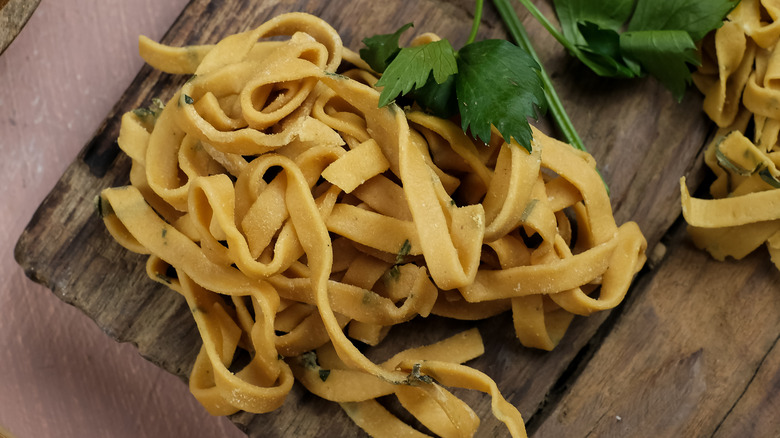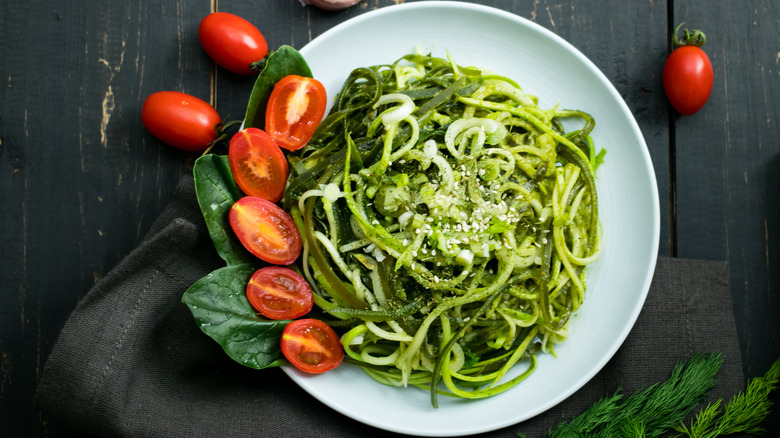13 Best Types Of Gluten-Free Pasta
Whether you're just starting to cut gluten from your diet or have eaten gluten-free for years, some foods are hard not to miss. Among the most celebrated and revered wheat-based foods, pasta is especially difficult to give up, particularly if you're used to eating the pantry staple regularly.
A few years ago, you could find only a few gluten-free options in the pasta aisle of grocery stores, and many of those left a lot to be desired. Times have changed, and now, the gluten-free among us have seemingly endless pasta options. It's true that many of them don't taste like your typical wheat pasta, but several come close. Others are delicious in their own right, even if you have to adjust your recipes to account for a slightly different taste and texture.
If you are trying to expand your gluten-free pasta horizons and want a better idea of what's out there, be on the lookout for these gluten-free pastas. Some are easy to find at your local grocery store regardless of where you live, while others may be easier to buy online. See something you never heard of? Don't be afraid to try something new and experiment!
Chickpea pasta
One of the most common types of gluten-free pasta lining store shelves these days is chickpea pasta. There's an excellent chance you have already seen this type of pasta at your local grocery store. Texture-wise, it's a bit denser than wheat pasta, and it also falls apart slightly easier. On the taste front, you can definitely tell that you are not eating wheat pasta, but that's not a bad thing. The flavor has a slight nuttiness that goes well with a variety of ingredients. If you cover your pasta in a flavorful sauce, the taste difference won't even be that noticeable.
Chickpea pasta is made from chickpea flour, i.e., ground chickpeas. According to Healthline, it provides more fiber, iron, and protein than traditional wheat pasta, so it is a good option if you're looking for something that's a bit on the healthier side. Chickpea pasta also comes in a wide variety of shapes to ensure you can create your favorite pasta dishes. Just make sure you check the ingredient list to ensure it doesn't include any unexpected gluten.
Brown rice pasta
If you're looking for something that doesn't feel quite as dense as chickpea pasta, you may want to try brown rice pasta. It's another gluten-free pasta commonly found in grocery stores, and we don't think the taste is too far off from the traditional wheat stuff. SF Gate says brown rice pasta is also nutritionally comparable to whole wheat pasta. For a healthy, filling source of carbs, brown rice pasta is a good option.
When you make brown rice pasta, expect a subtle nutty flavor that adds an extra layer of complexity to pasta dishes. While you can just replace wheat pasta with brown rice pasta without too many other concerns, keep in mind that brown rice pasta often takes longer to cook. Simply add a few minutes to your cook time (it's always best to follow the directions on the box) when making brown rice pasta a part of your meal.
Rice noodles
Are you looking for a pasta replacement for your favorite Italian meals? You're probably not going to choose rice noodles. Instead, these noodles are popular in many types of Asian cuisine, so you can easily continue to cook all the noodle-centered Asian recipes you enjoy.
Rice noodles aren't created specifically for people choosing to eat a gluten-free diet, but they are a good option if you are attempting to eat less gluten. According to the Gluten Intolerance Group, it's important to read the package labels because some rice noodles include wheat. Nutritionally, rice noodles are very similar to plain white rice (via Healthline).
If you aren't yet acquainted with rice noodles, you will want to try them and will enjoy their neutral taste. They range from stringy to flat and, depending on the kind you choose, the texture can be anything from thin and flossy to bouncy and chewy. Experiment with different types of rice noodles to see which you like best.
Soba noodles
When you first hear that soba noodles are made with buckwheat, you may immediately assume that you shouldn't touch them on a gluten-free diet. We have some good news for you: Despite the confusing name, soba noodles made exclusively with buckwheat are gluten-free, according to The Gluten-Free Brothers. But make sure you check the package before buying these noodles because some contain wheat and are not gluten-free.
If you haven't tried soba noodles yet, you should seek them out. They are a staple in Japanese cooking, and NPR went so far as to describe soba as the "humble jewel of Japanese cuisine." Unfortunately, it can be difficult to find traditional Japanese soba at many U.S. grocery stores. If you're struggling to find the varieties without wheat, make your way to the local Asian market. Once you get your hands on buckwheat soba noodles, look up Japanese recipes that utilize this delicious ingredient or try the noodles in your favorite dishes — they're surprisingly versatile. If you're like us, soba noodles will soon become a regular in your pantry.
Red lentil pasta
For those who have tried chickpea pasta and just can't get over the texture, red lentil pasta may be a better fit. We love this gluten-free alternative because of its lovely flavor and similar-to-wheat texture. While chickpea pasta can have an undesirable rigidity to it, you won't have the same problem with red lentil pasta. We find that it's really quite similar to traditional wheat pasta.
Plus, if you're looking for a slightly healthier alternative to wheat pasta, you'll probably be happy with the red lentil variety. According to Plant-Based FAQs, you'll get more calcium, fiber, and potassium in red lentil pasta than in wheat pasta. There's also more iron and protein. If you're trying to limit your carb and calorie intake as well, it's good to know that red lentil pasta has less of both than wheat pasta. Add to that the fact that it's usually easy to find at most grocery stores, and you'll see why red lentil pasta is one of our favorites.
Corn pasta
If you ask us, one of the best gluten-free pastas out there is corn pasta. This stuff isn't for everyone, but if you love corn or corn tortillas, there's a good chance you'll enjoy how it tastes. Corn pasta looks much like traditional wheat pasta, though it tends to have a more intense yellow color. Most corn pasta is gluten-free, but you should still check the ingredient list to ensure the kind you're using doesn't include wheat flour.
There are a few things to keep in mind if you're going to be cooking with corn pasta. According to Delighted Cooking, corn pasta tends to fall apart easier than wheat pasta. Just think of what a corn tortilla does under the weight of a loaded taco, and you'll see why corn pasta does what it does. Therefore, you should keep a close eye on your corn pasta during the cooking process. If it stays in the water for a minute or two too long, you could end up with a mushy mess. For that same reason, you generally want to avoid including corn pasta in soup — within minutes, you may have to deal with congealed hunks of corn in your soup.
However, if you adjust recipes accordingly to deal with the slightly different texture of corn pasta, you may really come to enjoy what this ingredient has to offer.
Quinoa pasta
Trendy ingredients come and go, but quinoa seems to have some staying power. It burst onto the health food scene years ago and it doesn't seem to be going anywhere soon. It makes sense — its nutty flavor and versatility make it a popular ingredient for those who want to eat healthier without having to sacrifice taste or time. Quinoa's popularity meant that it was only a matter of time before quinoa pasta became a gluten-free option at most grocery stores. Now, you can find a wide variety of brands that feature quinoa flour or a mix of quinoa and some other grain (most often brown rice or corn). Personally, we don't feel like there's a huge difference between brown rice pasta and quinoa pasta except for the fact that quinoa pasta does have a nuttier flavor.
According to the Harvard T.H. School of Public Health, quinoa is a complete protein. It also includes essential amino acids with a good amount of fiber, so this pasta is a solid option nutritionally. You'll also love that it usually doesn't get as mushy as other gluten-free pasta varieties, though you should also pay close attention to ensure you're not undercooking it.
Yellow pea pasta
Newer to the market and produced by ZENB, yellow pea pasta is actually surprisingly good. This pasta is made exclusively with yellow peas, so it's appropriate for a gluten-free diet. You'll first notice its intense yellow hue, which looks especially appetizing when paired with colorful veggies. It also boasts many health benefits: It's high in protein and fiber and contains fewer carbs than traditional pasta, according to ZENB. But our favorite part is probably the fact that it cooks so quickly. Some ZENB pastas will be ready to go in less than three minutes of cooking. When you're hungry and can't wait to get some pasta on your plate, that's a huge benefit.
The only downside to this pasta is the fact that it's still pretty expensive — you'll pay far more for ZENB than traditional pasta at the grocery store. However, yellow pea pasta has a lovely texture and light, neutral flavor that can be difficult to find in gluten-free pasta, so for some people, that extra cost might be worth it.
Cassava pasta
Cassava is a root vegetable with a nutty flavor that's commonly found in cuisines all over the world. Countries like Thailand, Nigeria, and Indonesia utilize cassava frequently for a variety of uses. Now, this staple root veggie is used to make gluten-free pasta as well. Cassava flour contains a lot of carbs with resistant starch, which could help aid weight loss and improve gut health, and while it is low-fat, it also provides almost no protein (via Healthline).
For those looking to avoid the nuttier, more intensely flavored gluten-free pastas out there, cassava pasta may be one of your best bets. It has a neutral, unremarkable flavor that can easily be disguised with a flavorful sauce. We wouldn't say it's the best-tasting gluten-free pasta on its own, but we love it when it's combined with plenty of other ingredients. Per Experimental Wellness, you'll just want to make sure that you're cooking your cassava pasta for the correct amount of time. If you don't leave it on the heat long enough, it could end up dry and chewy, but leave it on for too long, and the pasta could start to fall apart.
Shirataki noodles
You may have recently heard of shirataki noodles. They're touted as a "zero-calorie" noodle that provide numerous health benefits. Also called konjac noodles and "skinny" or "miracle" noodles, they're made with a fiber called glucomannan that comes from the roots of a plant known as konjac. According to Healthline, they contain a lot of water, and studies have found that they may aid in weight loss and help lower cholesterol. However, some people find that these noodles also cause a number of digestive issues. If you're going to try shirataki noodles for yourself, you may want to eat a small serving before diving into a larger meal-sized portion.
While the health benefits may sound tempting, many agree that shirataki noodles have little to no flavor. Therefore, you may want to add them to a soup or another highly seasoned dish. That way, they can take on the flavor of the other ingredients. Also, before cooking, be sure to rinse the noodles very well with water to remove the fishy smell that they pick up in the package. Shirataki noodles can't be used as a replacement for every type of pasta, but they may be worth it if you want to try something new.
Hearts of palm pasta
Even if you have eaten gluten-free for a while, there's still a good chance that you haven't yet had the opportunity to try hearts of palm pasta. If that's the case, you may want to seek them out because they're one of the more interesting gluten-free pastas we've come across. Per Self, they have a relatively neutral flavor, but you might also notice a slight citrus note that could be compared to artichoke hearts. The light, fresh taste makes hearts of palm noodles a fun option for the warmer summer months when you want to make a refreshing pasta salad.
Texturally, undercooked hearts of palm pasta can be chewy, but if you cook it just right, you'll get a lovely al dente bite. It also doesn't break apart as easily as some gluten-free pasta, which makes it a smart choice when texture really matters.
Unfortunately, finding hearts of palm pasta at your local grocery store can be difficult. If you don't have a health food store within reach, you can look for them online. They tend to be on the pricier side, so you'll have to decide if the novelty is worth it when you have other gluten-free pastas at your fingertips. We think they're a fun option to try, though we probably wouldn't make them a kitchen staple.
Almond flour pasta
Almond flour pasta is a popular alternative to traditional wheat pasta for those who are looking for a healthier gluten-free option. Though it varies by brand, the labels typically include "low-carb" or "high-protein," and some simply call it keto pasta. According to Healthline, almond flour is one of the healthiest flours out there because it's packed with nutrients, including vitamin E, antioxidants, and magnesium.
Snixy Kitchen notes that almond flour alone creates brittle pasta, so it's often combined with other gluten-free ingredients like coconut, sweet rice, or tapioca flours. While almond flour may be the main ingredient, if you read the ingredient lists, you'll notice that commercial pasta makers often include these starches as well. You can also make almond flour pasta at home if you're willing to put in the time and effort it takes to mix and shape the dough yourself.
Almond flour produces a mild but slightly sweet pasta with a denser texture than what you might be used to with traditional wheat pasta. It's not our favorite flavor or texture, but when you consider all of the health benefits of almond flour, it's not a bad gluten-free option.
Zucchini noodles
Zucchini noodles (also affectionately referred to as "zoodles") often get a bad rap as tasteless, bland, and insubstantial (via Food52). And that's fair — if you eat a serving of zucchini noodles roughly equivalent to the portion size you'd choose for wheat noodles, you're probably going to end up hungry. But if you're trying to add more veggies to your diet or you simply want to switch up your salad routine, zucchini noodles can be fun and refreshing. You don't necessarily need a vegetable spiralizer to make zoodles at home — in our opinion, though, it is the best way to make them. You can also buy them frozen, though they can get mushy when you thaw them.
We think the best way to incorporate zucchini noodles into your diet is to add them to pasta salad. Choose another gluten-free pasta option, then add your zucchini noodles for some extra texture and flavor. When they're coated with a flavorful dressing and combined with other veggies, zucchini noodles can be fantastic.
